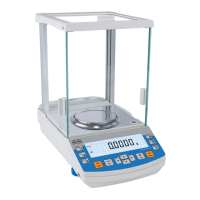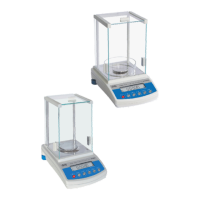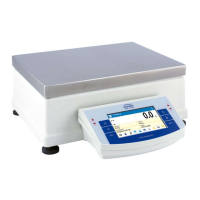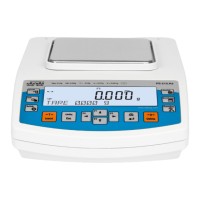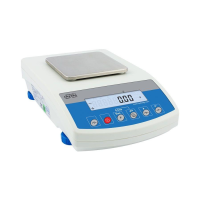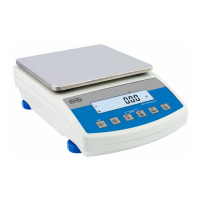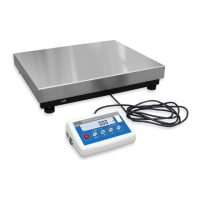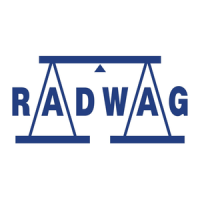
Do you have a question about the RADWAG AS 310.R2 and is the answer not in the manual?
| Maximum Capacity | 310 g |
|---|---|
| Readability | 0.001 g |
| Repeatability (Standard Deviation) | 0.001 g |
| Linearity | ±0.002 g |
| Stabilization Time | 2 s |
| Display | LCD |
| Communication Interface | RS-232 |
| Power Supply | 100 - 240 V AC 50 / 60 Hz |
| Operating Temperature | 10 °C - 40 °C |
| Calibration | External |
Details the available connection ports on the balance for peripherals.
Describes the features and specifications of the PS R2.H series balances.
Defines the proper application and purpose of the balance.
Outlines improper uses of the balance to avoid damage or incorrect results.
Specifies conditions that may invalidate the balance's warranty.
Explains the importance and frequency of monitoring balance's metrological characteristics.
Highlights the necessity of reading the user manual before operation.
Emphasizes the need for trained personnel to operate and maintain the balance.
Procedure for checking the balance and packaging upon delivery for damage.
Instructions on how to properly repack the balance for future transport.
Guidelines for selecting a suitable location and assembling the balance.
Step-by-step instructions for unpacking the balance and its components.
Procedure for ensuring the balance is correctly leveled for accurate measurements.
Instructions on how to safely clean the balance and its parts.
Steps for connecting the balance to the power supply.
Guidance on connecting external devices like printers or computers.
Instructions for safely connecting peripheral devices before powering on.
Information on the necessary time for the balance to stabilize after temperature changes.
Explains how to navigate through the balance's menu system.
Details the 'Adjustment' section of the user menu.
Details the 'Operation Mode' section of the user menu.
Details the 'Communication' section of the user menu.
Details the 'Devices' section of the user menu.
Details the 'Printout' section of the user menu.
Details the 'Other' settings section of the user menu.
Details the 'Information' section of the user menu.
Step-by-step guide for the initial login and subsequent logins.
Defines the different user access levels and their permissions.
Essential procedures for ensuring accurate and long-lasting balance use.
Instructions on how to zero the balance indication.
Procedure for determining the net weight of an object by excluding container weight.
Configuration options for parameters within the weighing mode.
Details the automatic taring function for packaging during weighing.
Settings for controlling how and when measurement results are printed.
How to select a measuring unit for a single weighing session.
Setting the default measuring unit used when the balance starts.
Configuring which measuring units are available for selection.
Defining custom weighing units based on a multiplying factor.
Customizing additional information shown on the balance display.
Setting custom text to be displayed on the balance screen.
Assigning functions to the F1-F4 buttons for quick access.
Explanation of the dual weighing range functionality.
Selecting the language for the balance menu descriptions.
Choosing user access levels for menu and settings modification.
Enabling or disabling audible feedback for button presses.
Adjusting the display's backlight level or turning it off.
Setting the current date on the balance.
Setting the current time on the balance.
Configuring the format for displaying and printing dates.
Configuring the format for displaying and printing time.
Performing an automated test to assess balance operation and diagnose errors.
Details on automatic and manual internal calibration processes.
Overview of adjustment settings accessible via the balance menu.
Procedures for manual internal, external, and user calibration.
Information on generating and printing adjustment reports.
Configuring data inclusion for adjustment printouts.
Customizing the header information for printouts.
Configuring data for GLP compliant measurement result printouts.
Customizing the footer information for printouts.
Options for creating custom printout formats.
Using variables to insert dynamic data into printouts.
Managing user accounts, including adding, editing, and access levels.
Managing product information like name, code, and thresholds.
Storing and managing tare weights for packaging.
Automatic saving and viewing of measurement data.
Using the ALIBI memory for storing a large number of measurements.
Procedure for exporting balance databases to external memory.
Procedure for importing balance databases from external memory.
Saving measurement data to an external memory device.
Enabling or disabling specific working modes for user access.
Using the balance to count small objects based on their average mass.
Mode for verifying if sample mass falls within defined low and high thresholds.
Mode for weighing samples until a target mass with tolerance is reached.
Calculating mass deviation percentages relative to a reference standard.
Mode for weighing objects in motion, often requiring different filtering.
Procedure for calculating the density of solid materials using a kit.
Procedure for calculating the density of liquid materials using a kit.
Collecting measurement data and generating statistical analysis.
Weighing and summing individual ingredients to determine total mass.
Function to register and hold the maximum measured value during a weighing.
Procedure for calibrating pipettes using the balance.
Configuring serial communication parameters for RS232 ports.
Configuring wireless network connection parameters for the balance.
Setting up communication between the balance and a computer.
Enabling or disabling automatic, continuous data transmission.
Configuring the balance to work with the E2R control system.
Configuring balance parameters for printing data.
Configuring the balance to work with a bar code reader.
Configuring the balance to work with an external additional display.
Setting up external TARE and PRINT buttons for balance operation.
Visual guide to cable connections between balance and peripherals.
Configuring the format of data sent to external devices.
Specifies the printout format when the PRINT button is pressed.
Format of responses from the balance to commands sent by a computer.
A table listing available commands for balance communication.
Describes how the balance responds to commands from a computer.
Detailed explanations of specific communication commands.
Description of the anti-vibration table for stable balance positioning.
Information about the rack used for under hook weighing operations.
Details on the kit for determining density of solids and liquids.
Features and specifications of the optional additional display.
